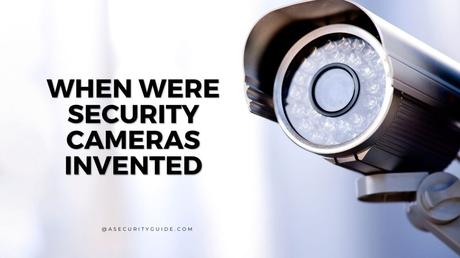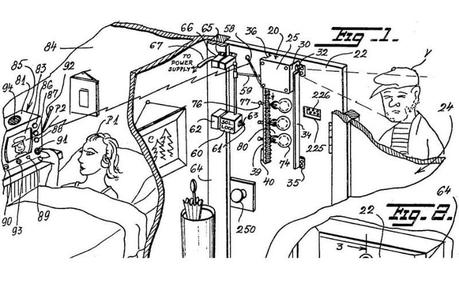In today’s world, security cameras have become an indispensable tool for safeguarding our homes, businesses, and public spaces. These devices play a crucial role in deterring crime, monitoring activities, and enhancing overall safety.
But have you ever wondered about the origins of security cameras? In this comprehensive article, we will explore the fascinating history of security cameras, from their early beginnings to the advanced systems we use today. So let’s delve into the evolution of surveillance technology and discover when security cameras were invented.

Early Beginnings: Leon Theremin’s Contribution in the 1920s
The journey of security cameras can be traced back to the 1920s when an innovative engineer named Leon Theremin made significant strides in surveillance technology. While Theremin is renowned for his invention of the Theremin musical instrument, his contributions to security camera technology are equally noteworthy. During this era, Theremin developed a system that closely resembled modern-day Closed-Circuit Television (CCTV) cameras.

Comparison Between Early Security Cameras and Modern CCTV Cameras
The early security cameras pioneered by Leon Theremin were primarily wired systems. They captured images and transmitted them through wired connections to a monitoring station. These early cameras laid the foundation for the CCTV cameras that are widely used today. However, it is important to note that the technology and functionality of these early systems were limited compared to the advanced surveillance systems we have today.
Advancements in Surveillance Technology: Transition from Analog to Digital Systems
The field of surveillance technology witnessed a significant transformation with the advent of digital systems. Analog systems were gradually replaced by digital surveillance technology, leading to enhanced image quality, storage capabilities, and ease of use. The introduction of closed-circuit television (CCTV) cameras revolutionized the industry, providing a more efficient and effective way of monitoring.
Digital Revolution: The Birth of IP Cameras
One of the pivotal milestones in the evolution of security cameras was the emergence of Internet Protocol (IP) cameras. IP cameras, also known as network cameras, operate by capturing and transmitting video data over an IP network.
These cameras offer numerous advantages over their analog counterparts, including higher resolution, improved image quality, and scalability. With the shift to digital systems, video footage could now be stored digitally, eliminating the need for VHS tapes and enabling more efficient video management.
Wireless Security Cameras: A Game Changer in Home Surveillance
The introduction of wireless security cameras brought a new level of convenience and flexibility to home surveillance. These cameras eliminated the need for complex wiring and allowed homeowners to easily install and relocate cameras as needed. Wireless cameras utilize Wi-Fi or other wireless protocols to transmit video data, providing homeowners with remote access to live feeds and recorded footage. This innovation led to the expansion of the consumer market for home security systems, making surveillance more accessible to a wider audience.
Integration with Smart Home Technology: A Seamless Security Experience
In recent years, security cameras have seamlessly integrated with smart home technology, offering homeowners a comprehensive security experience. Interconnectivity between security cameras and other smart home devices allows for synchronized operation and improved automation. Homeowners can now control and monitor their security cameras using voice assistants and mobile applications, enhancing convenience and accessibility.
High-Definition and Megapixel Cameras: Crystal Clear Surveillance
The introduction of high-definition (HD) and megapixel cameras marked a significant breakthrough in surveillance technology. These cameras offer superior image quality and greater detail, allowing for clearer identification of individuals and objects. With advancements in image sensors and optics, surveillance footage became more precise and useful for investigative purposes.
Infrared and Night Vision Technology: Monitoring in Low-Light Conditions
To address the need for round-the-clock surveillance, security cameras incorporated infrared (IR) technology and night vision capabilities. Infrared illumination enables cameras to capture clear images even in complete darkness, making them invaluable for monitoring areas with low-light conditions. These advancements have enhanced the effectiveness of security cameras in various scenarios, including outdoor surveillance and low-light environments.
Pan-Tilt-Zoom (PTZ) Cameras: Covering Every Angle
The introduction of Pan-Tilt-Zoom (PTZ) cameras revolutionized the way large-scale surveillance operations are conducted. PTZ cameras are equipped with motors that enable remote control functionality for panning, tilting, and zooming. This flexibility allows operators to monitor vast areas with a single camera, reducing the need for multiple fixed cameras. PTZ cameras find applications in public spaces, such as airports, stadiums, and city centers, where comprehensive coverage is crucial.
Video Analytics and Artificial Intelligence: Transforming Surveillance Capabilities
Video analytics and artificial intelligence (AI) have brought about a paradigm shift in surveillance capabilities. These technologies enable automated monitoring, object detection, facial recognition, and even license plate recognition. Video analytics algorithms can analyze vast amounts of footage, providing real-time alerts and enhancing situational awareness. With the integration of AI, surveillance systems have become more intelligent and proactive in identifying potential threats.
Cloud-Based Storage and Video Management: Effortless Data Management
The adoption of cloud-based storage for video footage has revolutionized the way surveillance data is managed. Cloud storage provides a centralized and scalable solution for storing and accessing video recordings from any location. It eliminates the need for on-site storage devices and offers enhanced data security, backup, and remote access capabilities. Centralized video management systems further streamline the administration and organization of surveillance data, facilitating efficient retrieval and analysis.
Mobile Viewing and Remote Access: Surveillance on the Go
With the proliferation of smartphones and mobile devices, security cameras have adapted to meet the demands of an increasingly mobile society. Mobile viewing and remote access features allow users to monitor their security camera feeds from anywhere, at any time. Real-time alerts and notifications keep users informed about events in their monitored areas, providing convenience and peace of mind.
Integration with Alarm Systems and Deterrents: Strengthening Security Measures
Security cameras have become an integral part of comprehensive security systems by integrating with alarm systems and other deterrents. The combination of surveillance cameras with alarm systems provides a multi-layered approach to security. Visible surveillance cameras act as a deterrent, deterring potential intruders and reducing the likelihood of crimes. The integration of security cameras with alarm systems enhances the effectiveness of both components, creating a robust security infrastructure.
Privacy Concerns and Ethical Considerations: Balancing Security and Privacy
The widespread adoption of security cameras has raised concerns about privacy and ethical considerations. Discussions surrounding the appropriate use of surveillance systems and the protection of individuals’ privacy rights have become increasingly important. Legislation and regulations have been implemented to ensure responsible camera usage, striking a balance between security needs and privacy rights. It is essential to be mindful of these considerations and respect privacy when deploying security camera systems.
Future Trends in Security Camera Technology: Advancing the Field
The field of security camera technology continues to evolve, driven by advancements in AI, machine learning, and biometric technologies. Predictive analytics, powered by AI and machine learning algorithms, enable more proactive and preventive surveillance measures. The integration of biometric technologies, such as facial recognition and fingerprint scanning, enhances the identification and authentication capabilities of security cameras.
Moreover, intelligent video surveillance systems that can understand and interpret video data are on the horizon, revolutionizing the way surveillance is conducted.
Summary
The evolution of security cameras from Leon Theremin’s invention in the 1920s to the advanced systems we have today is a testament to the relentless pursuit of safety and security. From early wired cameras to wireless and IP cameras, each technological leap has brought about increased accessibility, higher image quality, and improved functionality.
The integration of smart home technology, high-definition cameras, infrared and night vision capabilities, PTZ cameras, video analytics, cloud-based storage, and remote access has transformed the way we perceive and utilize security cameras. It is crucial to acknowledge the ethical and privacy considerations surrounding their use and ensure responsible deployment.
FAQs
Are wireless security cameras as reliable as wired ones?
Wireless security cameras have come a long way in terms of reliability. With advancements in wireless technology, they offer excellent performance and stability. However, factors such as signal strength, interference, and battery life should be considered when choosing between wired and wireless cameras. It is advisable to assess your specific security needs and consult with professionals to determine the most suitable option for your requirements.
Can security cameras be hacked?
While security cameras are designed to enhance safety, they can be susceptible to hacking if proper security measures are not in place. To minimize the risk of unauthorized access, it is crucial to follow best practices such as using strong passwords, regularly updating camera firmware, and securing the network infrastructure. Choosing reputable brands and implementing encryption protocols further strengthens the security of your surveillance system.
What is the difference between analog and IP cameras?
Analog cameras transmit video signals in analog format, requiring dedicated wiring and video recorders. On the other hand, IP cameras capture and transmit digital video data over an IP network, allowing for easier installation, scalability, and remote access. IP cameras offer higher resolution, advanced features, and seamless integration with other digital systems. They have become the preferred choice for modern surveillance applications.
How long do security camera recordings typically last?
The duration of security camera recordings depends on factors such as storage capacity, video resolution, frame rate, and motion detection settings. With the advancement of digital storage options, such as hard drives or cloud-based storage, it is possible to retain video footage for extended periods. The specific duration can vary from days to weeks or even months, depending on the configuration and storage capacity of the surveillance system.
Are there any legal restrictions on installing security cameras?
The regulations regarding the installation and usage of security cameras vary across jurisdictions. It is essential to familiarize yourself with the local laws, regulations, and guidelines governing surveillance systems in your area. Some key considerations may include obtaining consent for recording in certain locations, respecting privacy rights, and adhering to restrictions on camera placement. Consulting with legal professionals or local authorities can provide further guidance to ensure compliance with applicable laws.
